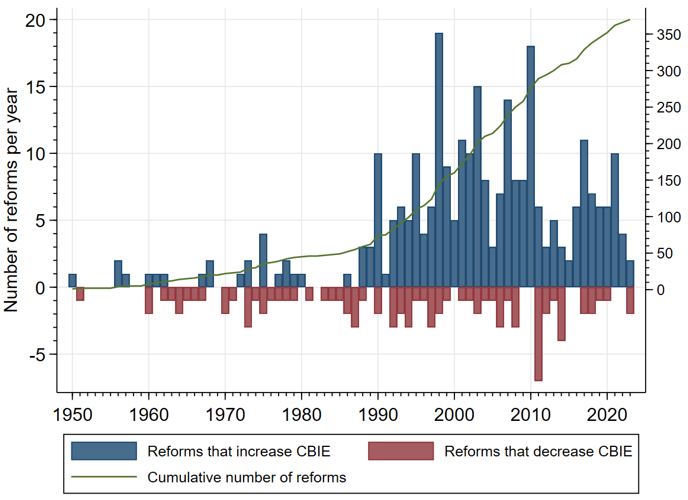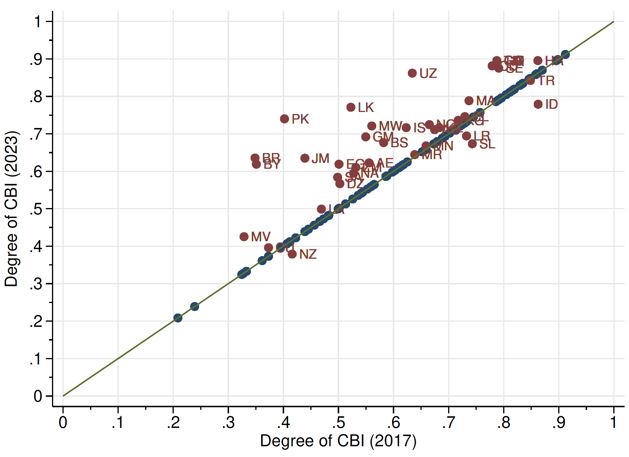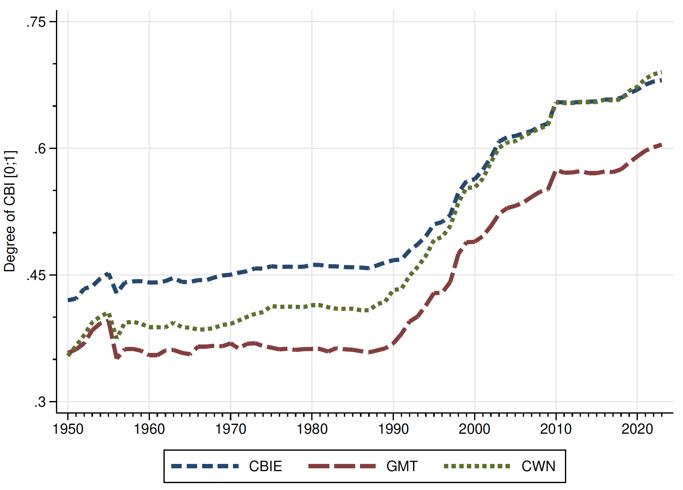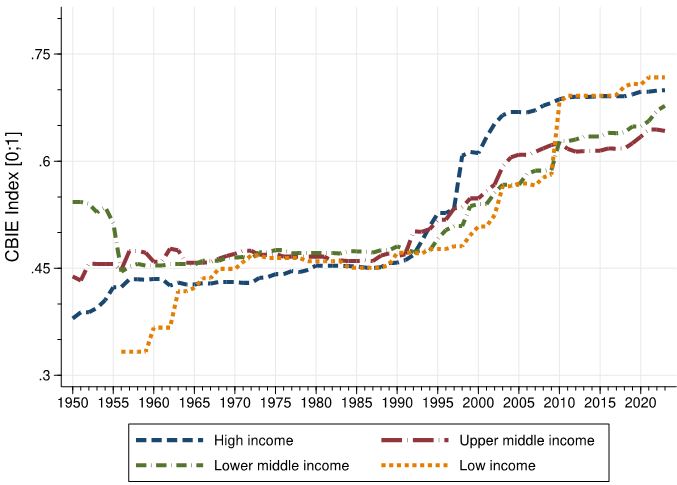

This Policy Brief provides an overview of the evolution of central bank independence across a large sample of 155 countries from 1923 to 2023. During this period, a total of 370 reforms in central bank design have been implemented. These findings highlight a remarkable global shift towards enhancing the independence of monetary authorities.
Recent trends indicate that, despite the challenges posed by the post-2008 financial crisis and the subsequent scrutiny on central banks due to the COVID-19 pandemic, there has been no slowdown in the momentum of central bank reforms. De jure central bank independence continues to be regarded as a cornerstone for effective economic policymaking.
Over the past fifty years, central banks around the world have progressively increased their degree of central bank independence, which is often considered the backbone of modern economic policy analysis (Masciandaro and Romelli, 2023).
However, following the COVID-19 pandemic, the surge in consumer price inflation and the monetary policy tightening implemented by many central banks around the world have contributed to the re-emergence of central bank independence as a major concern among politicians. Notably, former US President Donald Trump has publicly scrutinized the Federal Reserve’s handling of monetary policy via Twitter on several occasions (Bianchi et al., 2023).
To contribute to a better understanding of the evolution of central bank institutional design in recent years, in a recent paper (Romelli, 2024) I update the Central Bank Independence – Extended (CBIE) index introduced in Romelli (2022) to document trends in central bank independence across 155 countries during the period 1923-2023. This extension of the CBIE index by six years allows it to now cover data up to 2023. The period of coverage of the CBIE index is also extended from a historical perspective, as the data presented in this paper start in the year of the first available legislation, i.e. 1923 for Colombia, 1933 for New Zealand, 1934 for India, etc. The data on the CBIE index as well as those on the classical indices of central bank independence, i.e. the Grilli et al. (1991, GMT) and the Cukierman et al. (1992, CWN), are freely available at https://dromelli.github.io/cbidata/index.html, together with the full set of central bank legislations analyzed by the author.
To assess the number of reforms and trends in central bank independence (CBI), I meticulously gather all central bank charters and their amendments spanning the period from 1923 to 2023. Remarkably, over 2,000 changes to central bank legislation occurred during this extensive timeframe. However, it’s essential to recognize that not all legislative modifications significantly alter the institutional design of central banks. To measure the magnitude and significance of these changes, I focus my attention on reforms that change the degree of central bank independence.
Each year, when a change to the central bank charter takes place, I recalculate the value of the CBIE index. A reform is defined as the date when the CBIE index level changes. This process also enables the construction of an index of central bank independence that evolves over time. Through this historical exploration, I can identify a total of 370 reforms in central bank design, comprising 279 improvements and 91 reversals in CBI.
Figure 1: Central Bank legislative reforms (1950-2023)

Note: The figure shows the frequency of reforms that increased/decreased the CBIE index, together with the cumulative number of reforms in central bank independence between 1950 and 2023.
Figure 1 shows the distribution of reforms over time. A large number of reforms occurred during the 1990s, with a peak in 1998 when the European Central Bank (ECB) became the sole monetary policy authority for euro area countries. Subsequently, a wave of reforms emerged following the 2008 financial crisis. These changes were primarily associated with enhancements in independence, particularly concerning the governor and board. Simultaneously, decreases in the index corresponded to reforms related to central banks’ involvement in banking supervision. More recently, a final wave of reforms, primarily focused on strengthening central bank independence, became evident starting from 2016. This trend is further supported by Figure 2, which compares the degree of central bank independence as proxied by the CBIE index in 2017 and 2023. Notably, most countries lying above the 45-degree line exhibit evidence of a renewed commitment to enhancing central bank independence.
Figure 2: Reforms in Central Bank Independence (2017 vs. 2023)

Note: The figure compares the level of central bank independence proxied by the CBIE index in 2017 and 2023.
Figure 3 shows the level and trends in the indices of central bank independence presented in this paper. As suggested by the number of reforms in CBI presented in Figure 1, we can observe how the level of central bank independence across the CBIE, GMT, and CWN indices remained stable until the late 1980s. Subsequently, the average level of CBI experienced a steady increase until 2010. During the period following the Global financial crisis, from 2010 to 2015, the average level of CBI remained relatively unchanged. However, since 2016, a new wave of reforms appears to have commenced, focusing on enhancing central bank independence.
Figure 3: Evolution of Central Bank Independence (1950-2023)

Note: The figure shows the evolution of the CBIE, GMT and CWN indices of central bank independence between 1950 and 2023.
Figure 4 shows the evolution of the CBIE index from 1950 until 2023, categorized by economic development clusters: namely, high-income, upper-middle-income, lower-middle-income, and low-income countries, based on the 2022 World Bank classification. Surprisingly, in 2023 the average level of central bank independence (CBI) in low-income countries closely resembles that of high-income countries. This similarity follows a sharp increase in CBI experienced by these low-income countries in 2010, triggered by a large reform which brought a change in the degree of independence of the Central Bank of West African States from 0.36 to 0.81. Across all four groups — high-income, upper-middle-income, lower-middle-income, and low-income — central bank independence has been trending upward since the early 1990s.
Figure 4: Evolution of CBI by level of economic development

Note: The figure shows the evolution of the average degree of independence across central banks grouped based on the 2022 World Bank income classification.
This Policy Brief provides an overview of the evolution of central bank independence across a large sample of 155 countries from 1923 to 2023. During this period, I identify a total of 370 reforms in central bank design, highlighting a remarkable global shift toward enhancing the independence of monetary authorities. This shift is particularly noteworthy given the recent global challenges stemming from the 2008 global financial crisis, the COVID-19 pandemic, and the recent resurgence of inflation experienced by many high-income countries since mid-2021. These events have revived debates about the role and scope of central banks. The findings presented in this paper contribute to these ongoing discussions, offering a nuanced understanding of how central bank independence has been shaped and reshaped over a century. The increase in the degree of central bank independence, observed across countries with varying levels of economic development, signals a broader recognition of the importance of independent monetary policy in maintaining economic stability.
The insights drawn from this historical analysis emphasize the critical role of central bank independence, not merely as an academic concept, but as a vital component in shaping sound economic policies. The amendments brought to the Reserve Bank of New Zealand Act between 2018 and 2023 serve as just one example of the evolving mandates of central banks. Similarly, the recent inclusion of “environmental sustainability” as an objective in the Hungarian central bank legislation (in 2023) underscores the increasing pressure on central banks to align with governmental environmental policies and contribute to the global pursuit of net-zero emissions. These evolving mandates necessitate that central banks navigate uncharted policy territories, all while upholding their core mission of ensuring price stability.
Moreover, the evolving role of central banks is underscored by the recent emphasis on gender diversity. While only a handful of central banks explicitly include diversity as one of their objectives, notable steps have been taken. For instance, since 2017, the legislation governing the National Bank of Rwanda has mandated that at least 30% of its central bank board members must be female. Similarly, in 2023, the Central Bank of Sri Lanka introduced provisions for diversity within its board of directors.
The comprehensive dataset on central bank independence detailed in this paper could be used, in conjunction with the alternative indices proposed by Adrian et al. (2024) and Dincer et al. (2024), for future research aimed at investigating the effects of central bank independence on macroeconomic variables or the link between de-jure and de-facto indices of independence. Drawing inspiration from studies proposed by Ari et al. (2023) on inflation and Ioannidou et al. (2023) on political influences in governor appointments, researchers could leverage this freely available dataset to scrutinize the intricate relationship between de-jure independence and real-world policy outcomes. Of particular interest would be uncovering whether increased legal autonomy genuinely translates into tangible anti-inflationary success and whether it can effectively withstand the pressures arising from political appointments. Additionally, this research could shed light on how central banks navigate their evolving mandates, including environmental sustainability and gender diversity.
Adrian, T, A Khan and L Menand (2024) “A New Measure of Central Bank Independence”, IMF Working Paper No. 2024/035.
Ari, A, C Mulas-Granados, V Mylonas, L Ratnovski and W Zhao (2023), “One Hundred Inflation Shocks: Seven Stylized Facts”, IMF Working Paper WP/2023/190.
Bianchi, F, R Gómez-Cram, T Kind and H Kung (2023), “Threats to central bank independence: High-frequency identification with Twitter”, Journal of Monetary Economics, 135, 37-54.
Cukierman, A, S B Webb and B Neyapti (1992), “Measuring the Independence of Central Banks and its Effects on Policy Outcomes”, World Bank Economic Review 6: 353–98.
Dincer, N, B Eichengreen and J Martínez (2023), “Central Bank Independence: Views from History and Machine Learning”, mimeo.
Grilli, V, D Masciandaro and G Tabellini (1991), “Political and Monetary Institutions and Public Financial Policies in the Industrial Countries”, Economic Policy 13: 341-92.
Ioannidou V, S Kokas, T Lambert and A Michaelides (2023), “(In)dependent central banks”, CEPR Discussion Paper No. DP17802.
Masciandaro, D and D Romelli (2023), “Alex Cukierman, a pioneer of central bank independence”, VoxEU.org, 4 November.
Romelli, D (2022), “The political economy of reforms in central bank design: Evidence from a new dataset”, Economic Policy 37(112): 641-88.
Romelli, D (2024), “Trends in central bank independence: a de-jure perspective”, BAFFI CAREFIN Centre Research Paper No. 217.